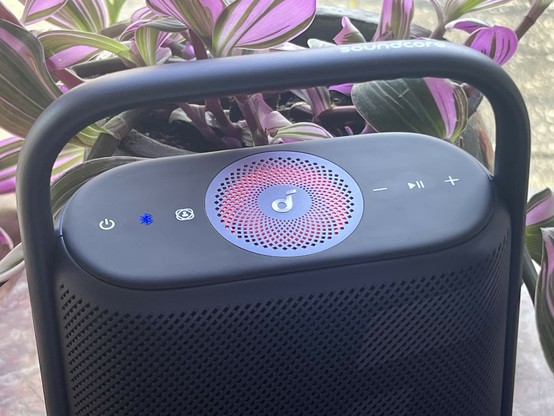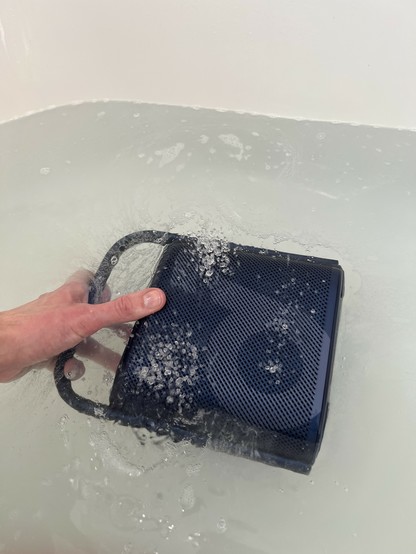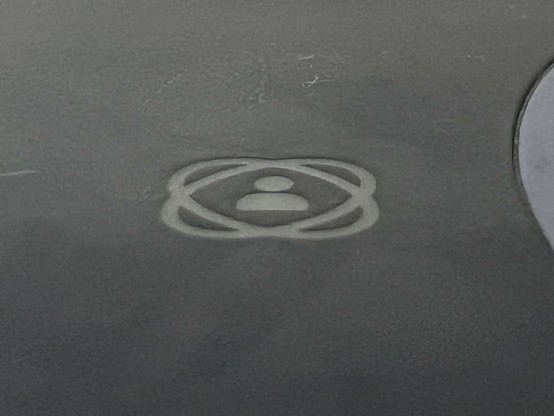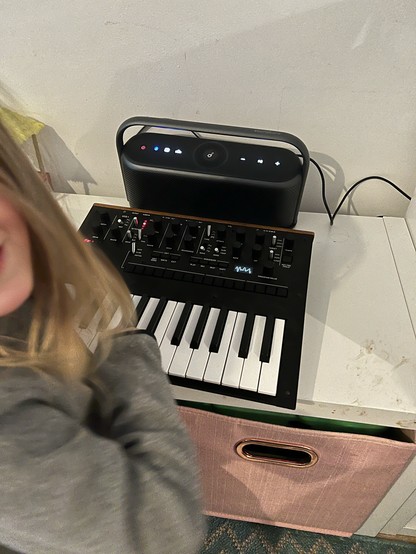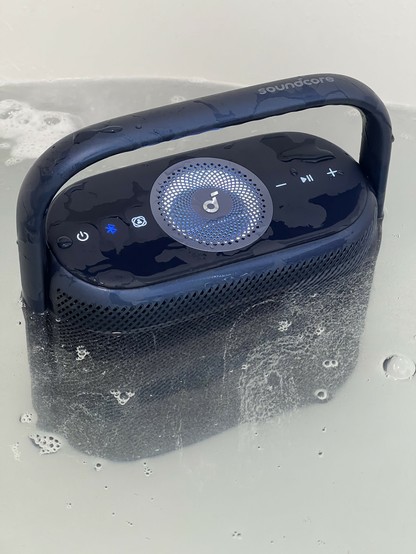soundcore Motion X500 Review
The Motion X500 isn’t supposed to be better than the motion X600, and yet somehow it is. soundcore have squeezed all the functionality of the X600 down into a smaller, almost mini bookshelf-speaker style package. Despite its smaller footprint it sounds every bit as punchy- I rarely push the volume past 60% – and now it just makes so much more sense – that smaller, bookshelf-like, footprint – to use two as a stereo pair.
It’s not all roses. In what seems like a stubborn rebuttal to my complaints about the soundcore branding needlessly sprinkled over the X600, soundcore have added more! Now the front grille is adorned with a huge, albeit relatively knocked-back, “d” logo. I can’t help but find it tacky on a device that otherwise looks incredible.
The X500 also loses the 3.5mm auxiliary input port. I have mixed feelings about this – I have precious few devices left with physical audio outputs, and fewer still that I’d consider using with a Bluetooth speaker. Additionally, having the rubber grommet open to reveal the aux port would compromise the water resistance of the speaker – it doesn’t make sense for something you want to chuck on a kitchen counter or out in the garden. But it was trying to hook up a little Korg synthesiser for the kids to play – it has no internal speakers of its own – that led me to notice this omission. Aux input is still useful, and I had to grab the X600 – which has one – to do this instead.
The top-firing speaker – for “3D” and room filling sound (this thing fills a room well, and a car too well – replaced our battery recently so we’re locked out of the stereo…) – has also been illuminated in the X500. Standing in stark contrast to the X600s, this LED backlit speaker serves as a subtle indicator for the current EQ profile and the “spatial sound” button from the X600 has become “EQ Switch” on the X500.
In retrospect the LED illumination on the X500 feels so right- and looks like a glaring omission on the X600.
Thus the X500 is an odd beast. It’s quite jarring how much has improved and changed versus its similar named and looking predecessor. It feels like an improved version of the X500 in many ways- smaller, refined, LEDs for the fun of it – while the naming suggests it’s a lite or “less good” version. It isn’t quite a 1:1 replacement – loss of aux input, making the X600 still a very valid choice for those who need one – but it’s so much neater than the X600 that I’d struggle to recommend it’s higher priced (£199.99 vs £169.99) sibling- though to confound this the X600 is currently a steal at £129.99 (discount and a voucher) from That Website and £169.99 direct from soundcore (though there was, briefly, £40 off as I was finishing this review). It almost feels like the X500 is replacing the X600, right?
Maybe lower numbers are better?
Build
Anyway the X500 is at least every bit as excellent as the X600. It has a very similar visual design, minimalist, with a sweeping, sculpted metal handle hiding the seam between its metal front grille and hard plastic back. It looks and feels premium with a satisfying heft- partly thanks to the battery, but like the X600 it’s no doubt physically smaller than you might think- and a sturdy build that’s clearly aimed at being rugged and luggable without compromising on those good looks.
I joked about testing the Soundcore X600 under water with bass on full volume- finally tried it with the X500. I used a Daft Punk Doin It Right remix for this, and not much happened until the bass dropped and then Instant Jacuzzi!
Bzzzzzzzttttttttttt
The front grille is evocative of a vintage radio or amplifier with the texture hinting not so subtly at that familiar woven diamond pattern of wire or fabric.
The colours have changed from the X600 with the X500 being available in Black, Blue and Pink versus the X600s Grey, Blue and Green.
On top the buttons have got closer together, squeezed into the smaller footprint. The power button has lost its distinct, recessed style but this isn’t a problem. Why? Well I complained about the lack of tactile feel, making the X600s buttons difficult for a partially sighted or blind user to find, and this seems to have been fixed in the X500. Whether by accident or intent, each button feels rough to the touch and perhaps – to a more experienced user than I – distinct enough to tell apart. In fact, even I can feel “volume down” and work from there.
It’s hard to tell by eye, but the X500s button icons are slightly inset which makes finding them by touch much, much easier.
From left to right the buttons are Power, Bluetooth (lit up in blue), EQ Profile and then after the top firing speaker come Volume Down, Play/Pause and Volume Up.
The buttons are smaller, with a little less give than the X600, this means they require a little extra actuation force – I’d almost say they are difficult to press even for me – and thus users who struggle with firm buttons may find this an issue. On the plus side, avoiding touch sensitive buttons here means they continue to work reliably when the top is wet- from rain or wet hands.
Underneath the X500 the X600s intentionally designed but small pointed feet have been replaced by two, mostly flat rubber C-shaped feet at each end. I hypothesised the old design was to isolate the speaker from the table – you can buy pointy feet for speakers, right? – but some testing with the X500 and the absurd bass of Karsh Kale’s Distance suggests this isn’t really an issue.
Around the back is the bass port and USB C port, both down on the bottom third of the device with the rest being clean, featureless plastic that soundcore thankfully resisted adorning with another logo.
As with the X600 there’s not a slither of give or flex in any part of the X500’s enclosure. It’s built – to overuse a terribly British phrase – like a brick outhouse. Again the metal front is joined by a plastic back that’s difficult to visually distinguish but the vague hint of some injection moulding lines and the less cold to the touch feel of the plastic makes it clear that it is – indeed – plastic.
The elephant in the room of course is that this build – clean and minimalist as it is – defies any attempt to figure out how to take it apart. I’ve watched teardowns of the X600 and it’s not exactly a walk in the park- if the battery dies… when the battery dies… you’ll struggle to replace it. It can be done, sure, but it won’t be fun.
The sealed waterproof design makes the X500, despite its deceptive weight, float. If it happens to fall into a hot tub or swimming pool you won’t need to fish about underwater for it.
Sound
There’s one word that aptly describes the Motion X500s sound: surprising. Perhaps because the X500 feels so much smaller than the X600 – despite being roughly the same overall volume. The X600 was surprising enough, but having much the same sound and volume coming from something with roughly 60% of its table-top footprint (yes it’s a good two inches taller) seems even more impressive. While the X600 was rated at 50W, the X500 comes in at 40W. I can’t readily tell the difference between the two.
Suffice to say I’ve rarely pushed the Motion X500 beyond 60% volume, and usually keep it a little lower since the kids – youngest will plonk the speaker down on the floor and do a little dance to indicate he wants music – get a little close.
As I alluded to earlier, we’ve also got locked out of our car stereo- a problem that is entirely fixable, but also entirely not something I can be bothered to deal with right now. Turning the X500 on and throwing it into the car boot gives car-filling audio that isn’t interrupted by the ignition or reliant upon the battery – yeaaaah we figured out our battery was well overdue a replacement when I played music in the car for 10 minutes while parked and it wouldn’t start afterwards.
Some confusion remains about the “spatial sound” chops of the X500. The product page references a spatial sound button, but the manual suggests this has changed to the EQ Profile switcher. There are three EQ profiles baked-in- “Spatial Signature”, “Spatial Dynamic” and “soundcore Classic.” Despite the LEDs in the top firing speaker being “RGB” soundcore have chosen the utterly bonkers options of “White”, “Cold White” and “Warm White” to disambiguate these. You can tell them apart when cycling through, but they’re not great at a glance. You can set a “Custom” EQ profile (great for tapering off the bass so you don’t shake your kitchen cabinets off the wall) with a custom colour, but the EQ button does not include this in the rotation- so you’ll need to switch to it via the app. This is… okay… I guess, but the kids will mash all the buttons at random and switch out of it.
Anyway I don’t know if the “Spatial” EQ profiles do anything specific relating to spatial audio and – as with the X600 – my lack of stereo hearing makes it impossible for me to really tell. Whatever the X500 is doing it sounds great and it’s louder than you’re probably going to need.
Like the X600, the X500 also includes microphones for handling calls. While I was skeptical of this feature in the X600, I’ve actually picked up a couple of calls on the X500 and it’s been great. Voice volume is a little lower than music, presumably to help avoid echo, and I haven’t had any complaints about the quality.
Once again I am left wanting two identical speakers to try TWS setup. Unfortunately the X500 wont connect with the X600 to create a stereo pair so this luxury eludes me.
The Not So Good
The lack of auxiliary input makes the X500 much less of a do-everything speaker. I can’t hook it up to a synthesiser, or jack it into a laptop when I don’t want to faff about with Bluetooth. It’s admittedly not something I do often with the X600, but since soundcore’s offering was so good that I gave away a bunch of my other speakers… well that aux is really useful!
The aux input on the Motion X600 was actually quite useful, and a glaring omission from the X500!
As with the X600 the X500 is only IPX7. That means it’s waterproof to one metre for thirty minutes, but has absolutely no dust, sand or grit protection. That’s easy to tell just by looking at it – the grille is a big, inviting nest of holes for dust and sand to work their way into and you should be careful taking the X500 to the beach. Consequently it also has pretty poor grime protection- it’s already got some grime mashed into the grille. It would take some tlc with a soft toothbrush to clean effectively – so perhaps ( despite being more than rugged enough physically ) not the best speaker to have around babies and toddlers. You can just dunk the whole thing in the bath to clean it, but it takes a while to dry afterwards.
The handle is fixed to the speaker, and can’t be collapsed or removed for travel. This bugs me a lot less on the X500 than it did on the X600- the narrower speaker makes for a more hand-sized handle that feels less like it’s taking up space.
The huge “d” logo on the front is completely unnecessary – I appreciate that soundcore still have something to prove, but I’d suspect the average user would wonder what “that backwards beats logo” is. Some brushed metal lettering spelling out “soundcore” might have looked better, and unambiguously communicated the brand.
The App
The soundcore app works with the motion X500, giving access to a custom EQ profile and LED lighting combination. You’ll also be able to upgrade the firmware, find the user manual and change some simple settings such as “Auto off” time. Unlike the X600 you’ll need the app for the X500 to both configure and activate your custom EQ profile. If you’re not a huge fan of very present bass (I miss the bass button on the X600 that could be used to take the edge off) then you’ll need the app to tune the EQ accordingly.
As far as I can tell, the X500 will remember the last EQ preset and custom colour chosen between uses- but if you press the EQ button you’re going to switch back into the presets.
Overall
Like it’s predecessor the X500 is incredible. The same great build quality – repairability notwithstanding – and good looks are refined into a smaller footprint. It charges from USB Type C so your phone or laptop charger will probably do in a pinch – there’s no power supply in the box – and you can also use an external battery pack to extend the runtime, albeit at the cost of the waterproofing.
Full immersion testing?
You betcha!
Well… mostly.
Water was not wasted on scientific purposes- but shared with the bath’s occupant 🤣
The X500 is just different enough from the X600 that it’s still a coin toss between the two. If you want a refined and more accessible speaker with a smaller footprint then the X500 is the clear winner- it would be excellent for a dual speaker bookshelf setup using TWS (True Wireless Stereo). If you want aux input and for bass attenuation to be a button press away then the X600 is the right choice.
As with the X600 I can’t emphasise enough how great the X500 sounds. It’s a loud, punchy, room filling, portable speaker in a small package that should hold up easily to the abuses of indoor and outdoor life. I often use mine in the kitchen to play music from my phone, and being able to play/pause and skip tracks, keeping wet or messy hands away from my phone, is very useful.
Nonetheless I still maintain that an easily replaceable battery would be nice. But it doesn’t bother me as much as it should. A sealed, almost impossible to service speaker should represent the antithesis of what I’d want to see in a product, but would serviceability impact the cost? The durability? Maybe, maybe not. If it matters to you, then avoid these speakers. If it doesn’t- well the X500 is really rather nice and you can grab it from soundcore for £169.99.
